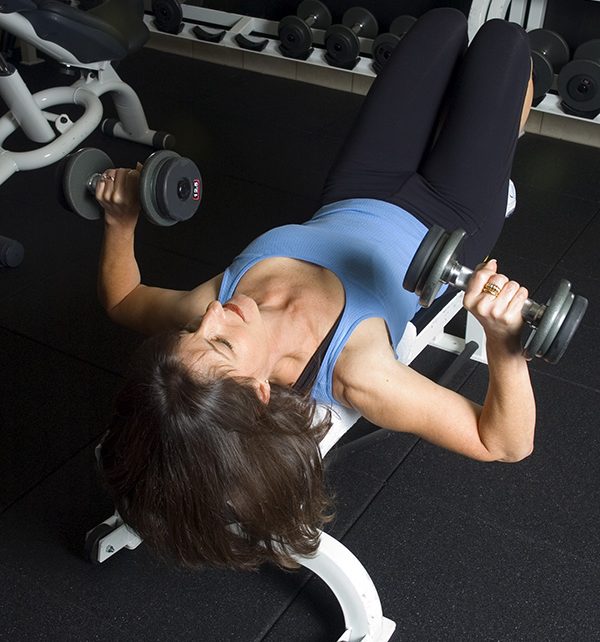The dumbbell bench press will come pretty close to a total upper body workout and it is especially good as a chest miracle worker. This exercise activates a host of upper body muscles and will create a firmer and shapelier chest and upper body for you.
Some ladies don’t train chest, but they should. Perhaps these muscles don’t figure high on the priority list for your training program. The muscles of the chest are not readily or directly visible to women as is the case in men, so it does become understandable that the chest is often forgotten.
Why is it important to train your chest? First, a well-developed chest gives you plenty of functional strength. Second, even though you can’t see the muscles per se, you can see the clear effects of having toned and firm chest muscles, because they will help lift and fill out the appearance of the upper body. Not completely happy with your chest? The solution lies in the gym, as your chest structure can be improved and firmed by resistance training.
Although there are many machines that will target various regions of the chest, free weights offer an alternative to machines because they can increase your overall muscle quality, balance and coordination – arguably in a fashion that exceeds that offered by fixed machines. An excellent free-weight exercise for the chest, arms and shoulders is the bench press using dumbbells. It is really an all-around excellent exercise for improving the quality and fullness of your entire chest, but it will also firm your shoulders, muscles of the rib cage, some upper back muscles and arm extensor muscles. Female athletes have successfully used bench presses to improve their upper body strength for sports as diverse as swimming, volleyball, softball and tennis, to name a few.
Bench presses have a wide-reaching impact on many torso muscles and as a result, they been used as a successful therapeutic tool. In a study by Ohira and colleagues (2006), bench presses were shown to improve breast cancer survivors’ outlook on life. In this study, about 80 percent of women who did bench press resistance training twice a week had improved quality-of-life survey scores. This compared to only 51 percent of participants in a control group. This study is the first to show that weight training and specifically bench presses helps women who have had breast cancer, and there are many other studies to show the overall benefits or resistance exercise in firming muscles in women.
Anyone can benefit by adding bench presses to her training program. In addition to its superior activation of the pectoralis muscles of the chest, it will result in outstanding improvement in muscle shape and firmness of your deltoids (shoulders), triceps (arm extensors), latissimus, intercostal (muscles of the rib cage) and serratus anterior (scapula muscles). Thus, the dumbbell bench press is a great exercise for your upper body if you are short on time, because it does not limit itself to one region of one muscle.
Muscle Structure And Function
Dumbbell bench presses strongly activate the pectoralis major muscles of the chest. The pectoralis major muscle is shaped like a large fan. It covers the upper (superior) part of the rib cage and its outside (lateral) border forms the front (anterior) wall of the armpit (axilla). The pectoralis major muscle has two heads. The clavicular head lies along the anterior lower surface of the clavicle (collarbone). The sternocostal head of the pectoralis major muscle begins on the manubrium (the top portion of the sternum), the upper six costal cartilages (cartilages at the ends of the ribs that attach to the sternum). It also attaches to the tendon-like portion of the superior part of the external oblique muscle (a lateral muscle of the abdominal wall). The sternocostal head is preferentially activated by flat bench presses. The clavicular and sternocostal heads converge on a groove near the head of the humerus (intertubercular groove) near the shoulder joint.
Both heads of the pectoralis major muscle adduct the humerus bone (draw the arm toward the midline of the body) and they medially rotate the humerus at the shoulder joint. They also flex the humerus bone by moving the upper arm anteriorly (or toward the front of the body) and this is the major function achieved in a bench press.
The triceps brachii is a three-headed muscle and its purpose is to extend the forearm at the elbow joint. This muscle is active during the upward push of the bench press. The fibers in the lateral head of triceps brachii run from a small vertical section of bone on the posterior part of the humerus (upper arm bone) starting about two-thirds of the way toward the shoulder joint and stopping short of the shoulder joint. The long head of the triceps brachii begins on the scapula (shoulder blade) just inferior to (below) the head of the humerus at the shoulder joint. The medial head of the triceps brachii is deeper and between the other two heads of the triceps. It encompasses two-thirds of upper and posterior part of the humerus bone. The fibers in all three muscle heads taper to attach to a common triceps tendon that crosses the elbow joint to attach to the olecrenon on the ulna bone of the forearm. Therefore, contraction of the triceps brachii muscle primarily causes extension of the forearm at the elbow (straightens the elbow joint).
Dumbbell Bench Presses
1. Choose two medium/light dumbbells in which you can get 12-15 repetitions in the exercise. Place the weights on the floor at the end of a flat bench. Stand at the end of the bench and pick up the dumbbells in each hand.
2. Place each dumbbell on the front of each thigh, and then carefully sit down on the bench. Next, lie supine (on your back) with the dumbbells still on your thighs. Flex your hips and lift the dumbbell off of your thigh so that the dumbbells are at your shoulders. Place your feet on the floor, or if you have a bad lower back, put them on the end of the bench. This will protect your back as you are getting into position. Alternatively, you can lie on the bench and have a training partner hand you the dumbbells.
3. The elbows will be bent. Turn your hands so that your palms are facing your feet. Start with the dumbbells adjacent to each axilla (armpit).
4. Take a breath and exhale as you push the hands upward by extending (straightening) the elbows. You will be pushing from a wider position at the bottom to a position at the axilla to a closer position at the top of the movement, where the weights almost (but not quite) come together over your chest. This is like an “A” type of a press. Make sure that you are in control of the weight in this position before going to the next step.
5. Reverse the movement so that the dumbbells move from a position where they are close together at the top, to one that is wider at the bottom as you carefully control the descent of the dumbbells. Inhale as the weight is being lowered. Stop when the dumbbells are almost at the axilla.
Moving the hands from a wide position to a narrow position emphasizes the outer portion of the sternocostal head of the pectoralis major at the bottom of the movement. As the dumbbells come closer together near the top of the lift, the more medial (central) parts of the clavicular and sternocostal heads of the pectoralis major are recruited. As a caution, the dumbbell press performed on a flat bench could aggravate a prior rotator cuff injury. This is because the rotator cuff muscles limit movements of the glenohumeral (shoulder) joint posteriorly as the dumbbells are lowered. Normally, only heavy weights performed multiple times for many years will increase the potential irritation to the rotator cuff muscles, so this should not become a problem. Thus, your exercise form should be excellent and your choice of resistance should be appropriate as this will help to strengthen your pectoralis and other torso muscles without harming the rotator cuff. With this approach, you should be able to benefit from the advantages and minimize any potential downsides of the dumbbell bench press.
The dumbbell bench press will come pretty close to a total upper body workout and it is especially good as a chest miracle worker. This exercise activates a host of upper body muscles and will create a firmer and shapelier chest and upper body for you. The indirect effects on your posture and shape will be almost unbelievable if you stick with this exercise and try to slowly progress to heavier weights over time. This does not mean that you have to be a world-class powerlifter to appreciate the transformations that are possible by this very basic and simple (but not easy) exercise. However, you do have to acquire the resolve to do it regularly and with some effort. Consistency is the key to success in any exercise program and consistency in dumbbell bench presses will revolutionize your chest.
References:
Baker DG and Newton RU. An analysis of the ratio and relationship between upper body pressing and pulling strength. J Strength Cond Res, 18: 594-598, 2004.
Doan BK, Newton RU, Marsit JL, Triplett-Mcbride NT, Koziris LP, Fry AC and Kraemer WJ. Effects of increased eccentric loading on bench press 1RM. J Strength Cond Res, 16: 9-13, 2002.
Garner BA and Shim J. Isometric shoulder girdle strength of healthy young adults. Clin Biomech, 23: 30-37, 2008.
Herrero F, San Juan AF, Fleck SJ, Foster C and Lucia A. Effects of detraining on the functional capacity of previously trained breast cancer survivors. Int J Sports Med, 28: 257-264, 2007.
Moore, K.L. and A.F. Dalley. Clinically Oriented Anatomy. Fourth edition. Baltimore, Lippincott Williams & Williams, 685-720, 1999.
Norwood JT, Anderson GS, Gaetz MB and Twist PW. Electromyographic activity of the trunk stabilizers during stable and unstable bench press. J Strength Cond Res, 21: 343-347, 2007.
Ohira T, Schmitz KH, Ahmed RL, Yee D. Effects of weight training on quality of life in recent breast cancer survivors: the Weight Training for Breast Cancer Survivors (WTBS) study. Cancer, 106: 2076-2083, 2006.
Simao R, Farinatti PT, Polito MD, Viveiros L and Fleck SJ. Influence of exercise order on the number of repetitions performed and perceived exertion during resistance exercise in women. J Strength Cond Res, 21: 23-28, 2007.
The post Get a Firm and Shapely Chest first appeared on FitnessRX for Women.




